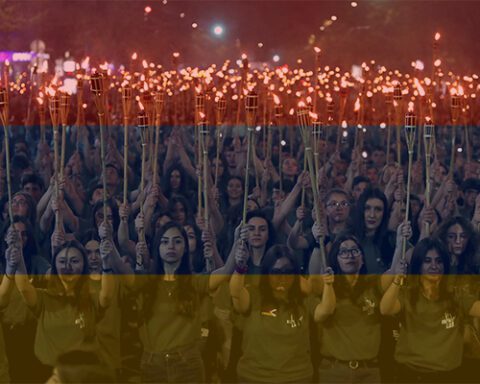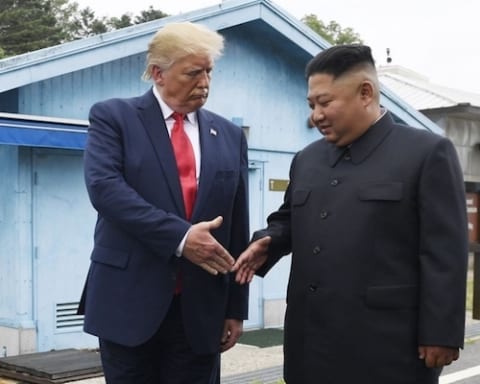14th of September – Lima Charlie’s South East Asia News Briefing: Philippines, Korea, Myanmar, China, Russia, South China Sea, Indonesia
Philippines
On Monday, Philippines President Rodrigo Duterte called for the withdrawal of all remaining U.S. Special Forces personnel in Mindanao, a major island group in the southern Philippines, home to over 100 U.S. soldiers under the Enhanced Defense Cooperation Agreement (EDCA). The EDCA, which has the goal to “promote peace and security in the region,” allows the U.S. to rotate troops into the Philippines, and build and operate facilities on Philippine bases, but the U.S. is not allowed to establish any permanent military bases. Under the EDCA the US currently has access to 5 military camps throughout the Philippines, and U.S. forces have assisted the Armed Forces of the Philippines in fighting terrorists, especially amid growing concern of the radical Islamist group, Abu Sayyaf, which has increased violence and kidnapping in the name of ISIL.
President Duterte said in a speech at an oath-taking ceremony for new officials, “These Special Forces, they have to go … I do not want a rift with America. But they have to go.”
Duterte claimed that the presence of U.S. troops is exacerbating tensions in the region, and creating resentment among militants adding, “They will really kill them (Americans), they will try to kidnap them to get ransom.”
Duterte stated that he had intended to raise this issue with President Obama at the ASEAN summit last week, but their meeting had been canceled after Duterte called the President a “son of a bitch” in response to a question from a reporter last Monday. When asked how Duterte would react if President Obama raised the issue of his support for the extrajudicial killings of more than 2,400 drug suspects that have occurred since his election in May, he responded:
“I am a president of a sovereign state and we have long ceased to be a colony. I do not have any master except the Filipino people, nobody, but nobody. You must be respectful. Do not just throw away questions and statements. Putang ina (son of a bitch), I’ll swear at you in front of everybody.”
The insult prompted Duterte to eventually backpeddle, and he released a statement expressing “regret it came across as a personal attack on the US President.”
President Duterte’s statement on the cancellation of his bilateral meeting with President Obama: pic.twitter.com/YsZf5IfdML
— Willard Cheng (@willardcheng) September 6, 2016
This was not the first time Duterte has used colorful language to describe a U.S. official, which has included digs at the Pope (whom he called a “son of a whore“). Back in August, he called the U.S. Ambassador to the Philippines, Philip Goldberg, a gay “son of a whore” after Goldberg expressed outrage at Duterte’s highly inappropriate comments about the sexual assault of an Australian missionary.
Questions continue to arise whether Duterte’s attacks on U.S. officials are the result of mistrust and hatred towards U.S. policy in the region. Following Duterte’s call for U.S. forces to leave the Philippines, his Presidential Spokesperson, Ernesto Abella said, “The statement reflects (Duterte’s) new direction towards coursing an independent foreign policy.”
Despite Duterte’s demand, Philippine Defense Secretary Delfin Lorenzana reportedly has assured that U.S. soldiers will remain in Mindanao, stating, “We still need them there because they have the surveillance capability that our Armed Forces don’t have.” Lorenzana added that he explained the importance of the EDCA alliance to Duterte, and that “it’s just right for us to remain allied with the US. They are still the dominant military force in this part of the Pacific. Our neighbors – Japan, Australia, South Korea – have military alliance with the US.”
During last week’s ASEAN summit in Laos, Duterte showed images of the “Bud Jao massacre” of 1906, when U.S. troops fought the Moro rebels on Jolo Island. The battle ended with the death of nearly 1,000 Muslims. Duterte has sought to argue that current U.S. operations are stirring resentment among Muslims in the Philippines, comparing them with past conflicts, such as the Bud Jao massacre.
Islamic conflict can trace its roots back to the 1500s when Spain invaded the Philippines and found a strong Muslim presence, after having expelled the Moors from Spain after centuries of fighting (Moros, the Spanish word for Moors, was given to the Muslim inhabitants). After the Spanish-American War, the U.S. fought numerous battles against the Moro, before the liberation of Mindanao against the Japanese in WWII. The colonization of Christian settlers created further conflict, however the majority of human rights abuses and atrocities against Filippino Muslims would be committed by the government of the Philippines.
In 1974, When the Moro National Liberation Front and the Philippine Armed Forces (PAF) were engaged in a fierce battle, the PAF burned the city of Jolo to the ground, massacring over 10,000 Moro and Chinese civilians. Subsequently, further human rights atrocities were committed by the PAF throughout the 70’s and 80’s. Due to decades of conflict, much of the southern Philippines, where groups like Abu Sayyaf and other Islamic groups operate, remain neglected. A consistent lack of proper schools, roads or hospitals, along with rampant corruption among local politicians and the Philippine National Police, have fueled groups like Abu Sayyaf and the MNLF.
Through the cooperation of the EDCA, U.S. intelligence agents and surveillance assets have assisted in numerous operations to counter ISIL influence in the region, while U.S. forces have also provided humanitarian and disaster assistance to communities. The current Joint Special Operations Task Force-Philippines (JSOTF-P) Duterte wants removed, originally set up to train Philippine military and police units to fight the Islamic terrorist networks, had actually wrapped up last year, with less than 30 soldiers remaining. This leaves many to believe that Duterte’s posturing is purely symbolic.
The Philippines and the U.S. share a long history, with deep military, social and economic ties. There are roughly 3.4 million Filipinos living in America, or 1.1% of the U.S. population, the largest group of Asians living in the United States. The U.S. remains among the Philippines’ top trading partners, and has been the Philippines’ largest foreign investor, with trade between the two nations at $17.3 billion.
Despite the new row between Duterte and the U.S., relations between the two nations remain strong. President Obama has made two trips to the Philippines during his presidency and 90% of the Filipino people view the U.S. favorably.
Duterte’s volatility, however, cannot be underestimated. On Tuesday, Duterte suddenly announced that he won’t allow government forces to conduct joint patrols of disputed waters near the South China Sea with foreign powers, so as not to upset Beijing, and that he was considering acquiring defense equipment from Russia and China, “where they are cheap and where there are no strings attached and it is transparent.”
With 75% of the Philippines’ arms imports having come from the U.S. since the 1950s (Stockholm International Peace Research Institute), there is much at stake between the two allies.
South Korea / North Korea
On Tuesday, two United States Air Force B-1B Lancer bombers flew over South Korea in a show of force and solidarity. Flying out of U.S. Pacific Command’s Andersen AF base in Guam, the bombers landed at the U.S.’s Osan Air Base at Pyeongtaek, 64km south of Seoul. The show of force comes four days after North Korea tested its 5th nuclear device in violation of UN sanctions, as reported by Lima Charlie News:
Admiral Harry Harris, commander of U.S. Pacific Command said, “These flights demonstrate the solidarity between South Korea, the United States, and Japan to defend against North Korea’s provocative and destabilizing actions.”
South Korea’s Defense Ministry spokesman, Moon Sang Gyun, told journalists that the fly-over was “aimed at sending a clear warning to North Korea about its nuclear test, and containing further provocations,” according to the Straits Times.
As tensions heat up on the Korean peninsula, the U.S. and its allies in the region look to hit North Korea with tougher sanctions. Sung Kim, the U.S. envoy to North Korea said “Our intention is to secure the strongest possible resolution that includes new sanctions as quickly as possible,” Kim told a news briefing after meeting his South Korean counterpart. Kim said the U.S. would work with China, North Korea’s major diplomatic ally, to close loopholes in existing resolutions, which were tightened with Beijing’s backing in March. Kim also mentioned that the U.S. is still open to a meaningful dialogue with Pyongyang on ending its nuclear ambitions.
China, which has voiced concern over the recent fly-over by the U.S., called on all parties to show restraint and avoid taking steps that increase tensions. However it remains unclear if China will support new sanctions to close loopholes. If China does support a new round of UN sanctions, it will likely require the U.S. and South Korea to refrain from deploying the disputed Terminal High Altitude Air Defense (THAAD) battery. As reported previously by Lima Charlie, China contends that the deployment of THAAD is aimed at spying on China, and not for the defense of South Korea.
Korean Central News Agency reportedly said, ”Any sanction, provocation and pressure cannot ruin our status as a nuclear state and evil political and military provocations will only result in a flood of reckless nuclear attacks that will bring a final destruction.”
It is unclear when the new round of sanctions aimed at closing loopholes will be implemented, or if they will receive support from China and Russia. One thing is certain, with the 71st UN General Assembly convening this week in New York, further sanctions will surely be a top priority of the UN Security Council.
Myanmar/ Burma
State Councilor Aung San Suu Kyi made her first official State visit to the U.S. to meet with President Barack Obama this week. On this highly anticipated two week State visit, Suu Kyi and President Obama are expected to discuss the further easing of U.S. sanctions to help investment in Myanmar as the nation continues to go through its democratic transition.
As reported by Lima Charlie, Suu Kyi successfully concluded the four day Panglong Peace Conference less than two weeks ago, where Myanmar government, military and armed ethic groups convened in an attempt at bringing peace and national reconciliation after over 60 years of conflict:
Peace for Myanmar? Panglong Conference Closes Amidst High Spirits
The United States has eased some sanctions against Myanmar this year in support of recent political reforms. However, the U.S. maintains targeted sanctions on individuals and companies that have ties with the former military regime and the military. There are roughly 100 individuals on the targeted sanctions list, including one of Myanmar’s vice presidents, Myint Swe. There also continues to be a blanket ban on rubies and jade from Myanmar, as most mining companies have ties with the military. Although some U.S. companies are operating in Myanmar, they remain under heavy scrutiny.
Business leaders in Myanmar continue to call for the lifting of sanctions, claiming that sanctions are crippling the economy and have greater impact on individual citizens than those on the targeted sanctions list. They also say that U.S. sanctions make Myanmar more reliant on China for economic growth.
Human rights groups believe sanctions should remain in place, at least until Burma’s 2008 Constitution is changed, or amended. The 2008 Constitution gave the military unyielding power over the government, reserving 25% of the seats in parliament to the military. It also grants the military the right to appoint ministers in three key positions, defense, home affairs, and border affairs. Under the constitution the military answers only to the Commander-in-Chief, and not to a civilian elected president. The military also has over reaching power to dissolve the government during a national emergency.
In a resent Human Rights Watch article, Asia Advocacy director for Human Rights Watch, John Sifton, said “Many of the Burmese on the U.S. sanctions list are criminal suspects and human rights abusers. The US should assist Burma in promoting genuine economic development, not help those who made ill-gotten gains during military rule.”
Suu Kyi, in response to U.S. sanctions has said, “We’re not afraid of sanctions. We’re not afraid of scrutiny … I understand and I accept and I believe that the United States is a friend, and are not keeping the sanctions to hurt us, but to [ ] help us. And I’m ready to accept that; I’m not afraid of sanctions.”
Although Suu Kyi isn’t fond of U.S. sanctions, it appears she may be using them as leverage over the military to reform, and allow for a full democratic transition to take place in Myanmar. Sifton said, “The sanctions are crucial for pressing the military to end rights abuses and transfer power to a civilian government. They shouldn’t be fully lifted until the democratic transition is irreversible.”
As Suu Kyi tries to rebalance Myanmar’s dependence on China towards the U.S. and Europe, it will be interesting to see what this State visit to the U.S. will yield in terms of the lifting of sanctions, and the strengthening of U.S.-Myanmar relations.
China and Russia: South China Sea
On Monday, China and Russia kicked off eight days of live fire drills in the South China Sea.
The exercises, called Joint Sea-2016, feature navy surface ships, submarines, fixed-wing aircraft, ship-borne helicopters, marine corps and amphibious armored equipment from both navies, the official Xinhua News Agency reported Sunday. According to Xinhua, “Island seizing” activities, including anti-submarine operations, will feature alongside live fire drills and island defense.
The drill comes at a time of heightened tension in the region. As reported by Lima Charlie, in July, The Permanent Court of Arbitration at the Hague ruled against China’s claims over much of the South China Sea. In response, Beijing rejected the ruling as little more than “waste paper,” and has vowed to ignore it.
China’s Defense Ministry has called the drills “routine,” stressing that they are not directed at any third party. However after recent events it’s hard to look past the fact that the drills are clearly directed at the U.S. and its allies in the region.
At last week’s Group of 20, in Hangzhou, China, Russia showed its support for China when President Vladimir Putin told reporters that Russia supports China’s stance on The Hague Court’s ruling.
Over the last year, this is the third naval exercise that Russia and China have engaged in.
Indonesia
On Wednesday, Indonesian security forces captured Muhammad Basri, deputy leader of the East Indonesia Mujahideen (MIT), and killed group member Andika Eka Putra. The operation was carried out by Indonesian police and military in the Poso District.
The capture of Basri comes two months after MIT’s leader Abu Wardah Santoso was killed in another operation involving 2,500 security personnel, including elite army troops and supported by drones.
The Jakarta Post reported that Basri was convicted of mutilating a junior high school student in Poso and was sentenced to 17 years in prison in 2007. He managed to escape, joined Santoso’s group in 2013 and became his second-in-command.
Indonesia has been fighting extremists since the 2002 Bali bombings that killed more than 200 people. This recent capture is yet another victory for Indonesia in the fight against extremists, but with other ISIS inspired militias remaining, the fight is long from over.
+++END
ASEAN Bureau, with Ray Pagnucco and Anthony A. LoPresti
For up-to-date news about South East Asia, please join us on Twitter at @LimaCharlieNews
Lima Charlie provides global news, insight and analysis by military veterans and service members Worldwide.
#ASEANNews #ASEAN #LimaCharlie #LimaCharlieNews






![Blossoming Russo-Turkish alliance leaves U.S., NATO behind [Lima Charlie News]](https://limacharlienews.com/wp-content/uploads/2019/07/Russia-Turkey-alliance-leaves-U.S.-NATO-behind-480x384.png)



